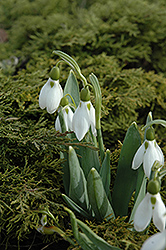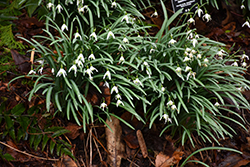Plant Height: 4 inches
Flower Height: 8 inches
Spread: 6 inches
Sunlight:
![]()
![]()
Hardiness Zone: 3a
Description:
Making an appearance in early spring, these light scented, nodding white flowers spring up from narrow, grass-like gray-green foliage; excellent for early color to beds and borders; can be used as groundcover; requires little to no maintenance
Ornamental Features
Common Snowdrop features dainty nodding white bell-shaped flowers with green tips at the ends of the stems in early spring. Its grassy leaves remain grayish green in color throughout the season.
Landscape Attributes
Common Snowdrop is an open herbaceous perennial with an upright spreading habit of growth. Its relatively fine texture sets it apart from other garden plants with less refined foliage.
This is a relatively low maintenance plant, and usually looks its best without pruning, although it will tolerate pruning. Deer don't particularly care for this plant and will usually leave it alone in favor of tastier treats. It has no significant negative characteristics.
Common Snowdrop is recommended for the following landscape applications;
- Mass Planting
- Border Edging
- General Garden Use
- Groundcover
- Naturalizing And Woodland Gardens
Planting & Growing
Common Snowdrop will grow to be only 4 inches tall at maturity extending to 8 inches tall with the flowers, with a spread of 6 inches. It grows at a medium rate, and under ideal conditions can be expected to live for approximately 10 years. As an herbaceous perennial, this plant will usually die back to the crown each winter, and will regrow from the base each spring. Be careful not to disturb the crown in late winter when it may not be readily seen! As this plant tends to go dormant in summer, it is best interplanted with late-season bloomers to hide the dying foliage.
This plant does best in full sun to partial shade. It does best in average to evenly moist conditions, but will not tolerate standing water. It is not particular as to soil type or pH. It is somewhat tolerant of urban pollution. This species is not originally from North America. It can be propagated by multiplication of the underground bulbs.


